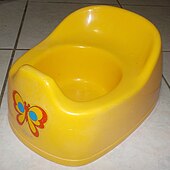
A urine deflector is a device for deflecting the stream of urine during urination. These may be part of a chamber pot, latrine or toilet intended for the purpose, or they may be deterrents, installed in the sides or corners of buildings to discourage their casual use as urinals by passers-by. They may be constructed in various ways from a variety of materials but are typically designed to have an angled surface which catches and redirects the stream.






